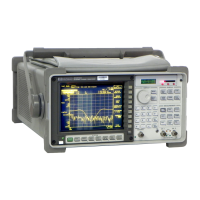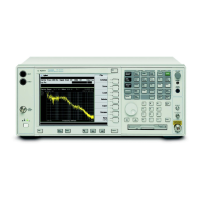4 Specify the measurement and averaging parameters.
Press [
Input
][
FRONT END CHx SETUP
], then press [
A WT FLTR ON OFF
] to highlight
OFF.
Press [
Avg
][
LINEAR
][
AVERAGE TIME
] <number> [
S
] (where <number> is 2 or
greater).
5 Press [
Scale
], then press [
AUTOSCALE ON OFF
] to highlight ON.
6 Turn on the calibrator, then press [
Start
].
7 When the measurement status line says “REAL-TIME MEASUREMENT,” move the
marker to the calibrator’s output frequency and enter calibrator’s output amplitude (in
dBSPL).
Press [
Marker
][
MARKER TO PEAK
].
Press [
Input
][
XDCR UNIT CHx SETUP
][
CAL VALUE AT MKR
], then type the calibrator’s
specified output amplitude (in dBSPL
rms
)and press [
ENTER
].
The analyzer uses the number you enter in [
CAL VALUE AT MKR
] to calculate a new
value for [
XDCR SENSITVTY
]. This new value is the calibration factor that ensures the
accuracy of your microphone measurements. The analyzer automatically stores this
value and the [
XDCR UNIT LABEL
] value in nonvolatile memory, so they will not be
lost at preset or power-down. However, the values will be used only when
[
XDCR UNIT ON OFF
] is set to ON.
Marker is placed on
calibrator frequency.
Amplitude readout is wrong until you
enter the specified calibrator output
with [
CAL VALUE AT MKR
].
Measurement status line.
Amplitude readout is correct
when you complete this task.
Agilent 35670A
Operator's Guide Measuring Sound
3-5

